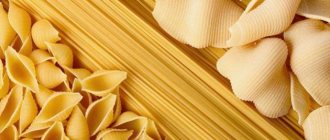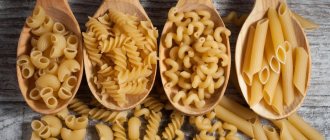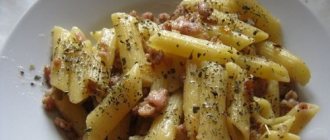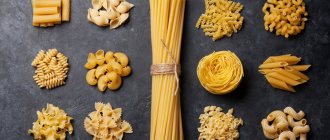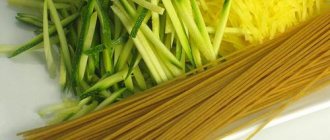As recent studies show, pasta is a frequent guest on Russian tables. True, Italians eat them more often. But eating large amounts of flour does not affect the figure of the inhabitants of the Apennine Peninsula. The thing is that Italian women relish spaghetti and farfalla made from durum wheat, while Russian women are content with pasta from the domestic food industry. Humanity has also come to the conclusion that the less we pre-process a product, the more beneficial it is for the body. In this article we will look at whole grain pasta. What it is? How are they different from regular noodles? You will learn this from our article.
What is a whole grain?
Typically, ears of wheat or rye are threshed on a threshing floor. In this process, the grain is cleared of the flower and amniotic membranes. Next, the cereal is crushed to a powder state. It turns out to be flour. The crushed grain particles are sifted through a sieve. As a result, we can talk about flour of the highest, first and other grades. Whole grain pasta is made from unrefined grains. The raw material can be rice (then it will not be white, but brownish or even brown), corn, oats, rye. Wheat ears are traditionally used to make pasta. Grain from them can germinate when placed in the soil and watered. It contains not only the embryo of the future ear, but also the endosperm, the aleurone layer of the shell. Such grain is simply ground and flour is obtained. Thus, the product is not subject to deep processing that changes its chemical composition and structure.
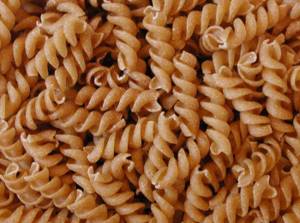
Whole grain pasta: benefits and harms. About the benefits of vermicelli from “Makfa”
The yellowish pasta familiar to everyone is made from wheat flour. According to their characteristics, wheat varieties cultivated by agriculture are either soft or hard.
To obtain flour, the grain is crushed and then sifted through a sieve in a factory setting. The grade of the finished flour (second, first, highest) will depend on the size of the cells in the sieve. However, do not confuse the difference between the type of flour and the type of wheat. Flour obtained from durum wheat can be second grade, which means it contains impurities, as well as sifting through a larger sieve.
Most of the pasta offered on the counter is made from premium flour obtained from soft wheat. But on the Russian market there are manufacturers who follow Italian technologies and produce pasta from flour obtained from durum wheat.
From a culinary perspective, durum pasta does not become mushy when cooked, creating the pleasant sensation of a firmer-tasting product. There is a misconception that the dietary qualities of such pasta differ from products made from soft varieties. This is not true, because their calorie content is exactly the same as that of regular pasta, and is 150 kcal per 100 g.
Among the advantages, manufacturers may note such a plus of durum pasta as a lower glycemic index, but this parameter is of little importance. More important is the insulin index, which is almost the same for all pasta and has a value of about 40. This is a good indicator that says that pasta can be consumed during a diet (unless you add fatty creamy cheese sauce to it).
All this information is in publicly available sources; consumers have stopped believing previous myths about the superiority of pasta made from durum wheat, so manufacturers have taken a new step, convincing everyone of the incredible health benefits of whole grain products.
The basis was the results of a study conducted by British scientists, which showed that those who regularly consume whole grain foods have a lower risk of developing a history of cancer or heart disease. By adding marketing here, you can present a product made from waste from the flour milling industry at a cost comparable to flour from premium wheat.
When obtaining flour for making whole grain pasta, the whole grain is crushed without sifting it on a sieve, which makes it possible to enrich the flour with parts of wheat germ, a very useful shell containing a complex of B vitamins, as well as iron, antioxidants, magnesium, etc.
If you compare regular pasta with products made from whole flour, the indicators will be as follows:
- Calorie content – 125 kcal versus 150 kcal for regular pasta;
- Protein content – 5.8 g versus 5.3 g;
- The dietary fiber content is 2.8 g versus 1.8 g for regular pasta.
The difference turns out to be insignificant, especially if we remember the daily intake of fiber (dietary fiber) for a person. If you follow them and try to gain this indicator only by eating whole grain pasta, you will have to eat more than a kilogram of it, which is 1250 kcal.
As for B vitamins, there are 2-5 times more of them in whole grain pasta than in regular pasta, but none of them can cover even 10% of the daily dose, so there is no need to consider the product as a serious source of these vitamins.
The difference in the glycemic index is also small - 32 for whole grain pasta and 40 for regular pasta. This means that such pasta will not cause sudden changes in blood sugar levels in any case.
It turns out that in terms of nutritional value, whole grain pasta is not much different from regular pasta, which does not allow it to be included in the section of dietary products recommended for weight loss. In terms of taste, whole grain pasta has quite controversial reviews. Some people liked their taste, while others promise not to look in their direction anymore.
Therefore, you should not rush and buy expensive pasta, wanting to lose weight. If you follow some tips, you can keep yourself in great shape and continue to eat regular pasta, just use the following tips:
- The pasta needs to be slightly undercooked;
- It is better to eat them in the first half of the day, and not in the evening for dinner;
- For seasoning, use a light sauce rather than a heavy sauce, which is typical for an Italian restaurant;
- Pasta is combined with vegetables and mushrooms;
- It is better to choose a type of product such as thin noodles or spaghetti - they have a lower glycemic index.
preparation of the article - Anna Korobkina, nutritionist
In this material we will try to answer a question that is so often asked by consumers of our products.
The standard pasta that everyone is familiar with is made mostly from regular wheat flour. Agriculture cultivates many varieties of wheat, and each, according to its characteristics, is classified as either hard or soft.
To obtain regular wheat flour, the grain is first ground and then sifted through a sieve. The type of flour obtained depends on the size of the cells - premium, first and second. The difference between a wheat variety and a flour variety should not be confused. Flour can be obtained from durum wheat, but be of the second grade - that is, with impurities, sifted through a larger sieve.
Pasta made
from wheat flour
is pure starch, purified of all “ballast substances”. In fact, this is a “carbohydrate dummy” - easily digestible carbohydrates that the body “puts aside in reserve” (in fat deposits) at any opportunity.
They say, “bread is the head of everything”
, our great-grandfathers meant the important role of cereals in nutrition. By excluding grains from our diet, modern man has almost completely cut off the supply of many vital components for the body, such as: vitamin E (the source of the health of our skin and liver), coarse plant fibers (fiber), and most minerals.
To obtain flour for the production of whole grain pasta, the whole grain is crushed, but not sifted through a sieve. And this is wonderful - parts of the germ, extremely useful shells with a complex of B vitamins, antioxidants, iron, magnesium, etc. get into the flour.
easy to distinguish from ordinary ones - they are brown. What is so special about them?
The fact is that by clearing the grain from the shell, which contains the vast majority of substances beneficial to the body, the manufacturer achieves lightening of the final product to “improve” its appearance. But he forgets that he is depriving himself of vitamins, microelements and fiber. All these components are contained many times more in whole grain brown pasta than in the usual light pasta. What gives pasta its dark color? Cellulose. Fiber is that part of the product that, while not being a source of energy, is extremely important for health. It is a plant fiber. Surely, while reading the postulates of proper nutrition, you have come across the phrase “ballast substances” more than once. The modern food industry often refuses these vital components, considering them unnecessary ballast. But food containing fiber is an important argument in the fight for slimness: it quickly causes a feeling of fullness, which lasts a long time. As a result, we eat less, feel full longer, and half an hour after lunch we don’t reach for sweet cookies or other additives in an effort to dull the feeling of hunger. This happens because fiber in the stomach absorbs water and swells, filling the volume. Accordingly, appetite decreases and we do not overeat. And as a gift - a bonus: removing toxins from the body and stimulating the gastrointestinal tract.
Be healthy and bon appetit!
Calories, kcal:
Proteins, g:
Carbohydrates, g:
The Russian company Makfa, which is one of the five largest producers of pasta in the world, was formed on the basis of the merger of the Chelyabinsk pasta factory and the Sosnovsky bakery plant. The share of the company's products in the Russian market is more than 23%. Every year Makfa produces about 180 thousand tons of various pasta. The company produces pasta under the Makfa brand, as well as Grand di Pasta and Smak. In addition, the company is engaged in the production of cereals and flour of various types.
Calorie content of whole grain pasta Makfa
Raw whole grain Makfa pasta contains 361 kcal per 100 grams of product.
Composition of Makfa whole grain pasta
Makfa whole grain pasta is wholemeal flour made from durum wheat and... Pasta may contain traces. According to the manufacturer, the pasta contains no dyes, food additives or GMOs.
The benefits and harms of Makfa whole grain pasta
If whole grain pasta is not overcooked, it is a source of healing properties. Pasta made from durum wheat contains vitamins, as well as microelements necessary for the body, such as, and. The main advantage of such pasta is the presence of complex carbohydrates in them. Since carbohydrates are not consumed immediately, but gradually, the body is provided with energy for a long time. In addition, the product is high in fiber and vegetable protein. Whole grain pasta increases resistance to stress and helps cope with insomnia and migraines, and also strengthens the heart muscle.
But it is important to remember that the calorie content of the product increases significantly if pasta is consumed with sauces, fried meat, cutlets, and so on. To prevent the appearance of extra pounds, preference should be given to vegetable sauces, stewed and. Also, for those who watch their diet, it is better to eat such food in the first half of the day.
Whole grain pasta Makfa for weight loss
When producing pasta from durum wheat, the grain is not sifted, but crushed. Thanks to this, such a product does not harm the figure and is even used in a number of diets. Whole grain pasta contains fiber, which helps remove toxins and cleanse the body.
Whole grain pasta has a lower glycemic index (GI 50 or lower) compared to pasta made from baker's flour (GI over 70). This means that they lead to a slower rise in blood glucose levels, which means they are much safer in terms of weight gain. In order for pasta to have a lower GI, it must be slightly undercooked.
In addition, complex carbohydrates, which are present in abundance in this product, relieve a person of hunger for a long time and allow him to avoid snacking. For those who cannot deny themselves such a pleasure as macaroni and cheese, in order to reduce the fat content of the dish, it is better to give preference to the varieties of cheese and, as well as soft ones - and.
Whole grain pasta Makfa in cooking
Whole grain pasta has a huge advantage over pasta made from soft wheat varieties, as they are very difficult to digest and do not lose their shape during cooking. This product can be consumed as an independent dish; pasta goes well with salads, seafood, and various meat and fish dishes. Pasta is the main ingredient for cooking; it can be eaten with cheese, and can also be used to prepare various soups and salads. And if you cook the pasta until half cooked, you can even bake it.
You can learn how to cook pasta correctly and how to distinguish high-quality whole grain pasta from low-quality ones by watching the video of the TV show “About the Most Important Thing.”
Especially for Copying this article in whole or in part is prohibited.
Good day or night to everyone. To everyone who writes interesting, useful, truthful and most wonderful reviews and articles on a variety of topics on this most informative site. To everyone who writes their reviews based only on their own experience, on their knowledge and on personal impressions.
I also welcome all grateful, attentive readers of reviews and articles. When a reader not only reads a review, but also receives a lot of useful and necessary information from it, and also leaves a comment on the review, this is wonderful. If he also expresses his personal An opinion about a product or service that you received from your personal experience is very interesting to read.
In my short review I want to share my impressions with you
It is pasta made from whole grain flour that has become increasingly popular, especially among those people who care about their health, their diet, and athletes. Such pasta can be purchased in a variety of supermarkets. You just need to carefully read what is written on the package.
Italians eat just such pasta in their diet. Moreover, they cook it “al dente”, that is, slightly undercooking, a little raw. That’s why they probably don’t get fat from eating a lot of pasta.
This type of pasta has become more and more popular here in Russia. Now pasta made from whole grain flour is consumed by athletes and children, and simply by those who try to watch their weight and eat right.
The main difference between these pasta products, of course, is that they are made from whole grains.
When making ordinary pasta, the grain is cleaned, threshed, then it is ground into powder and sifted several times, thus obtaining premium flour from which pasta, traditional for our country, is made.
If the grain is not threshed to remove its flakes, but immediately ground into flour and not sifted repeatedly through a sieve, but immediately made from such powder, pasta will be whole grain. Coarser, but still more useful.
When the grains are ground in this way, all the beneficial properties are retained and their chemical composition does not change at all.
The raw material for making whole grain flour can be not only the usual wheat, but also oats, rice, rye, and corn. But pasta is still traditionally made from wheat. But I once bought rye pasta in stores flour. Their taste, of course, initially is not very familiar, but then you get used to it and don’t see any special taste differences, except, of course, in color. Pasta made from whole rye flour is brownish-gray in color, like rye bread. For some reason now I’m into them I don’t see it in stores, but I would definitely buy it.
Whole grain pasta is a little different from regular pasta, it is a little grayer in color and takes longer to cook, and is a little harsh in taste. But this is exactly how it should be. Thus, it is more beneficial for our body than pasta made from first-grade wheat flour .
from such pasta.
For example.
Of course, you can cook them like ordinary pasta, season with melted butter and it will be a very tasty side dish.
You can also cook this pasta with some kind of vegetable sauce, for example lecho. It will be just as tasty and healthy.
You can cook anything from such pasta, just like from regular pasta made from wheat flour. For example, casseroles made from them are also very, very tasty.
Be sure to try these pasta products. I think you will like them and you will form your own personal opinion about their benefits.
Video review
| All(5) |
Nutritionists around the world say that the key to effective and safe weight loss is counting calories. But not only the amount of food consumed is important for weight loss. The quality of the products is also important, because we are what we eat. Among the right foods for a slim figure, whole grain pasta occupies a special place. It is believed that they help to lose unnecessary pounds and not gain new ones.
Regular pasta is most often made from premium flour, made from soft grains. Whereas traditional Italian pasta is made from flour made from durum wheat. This is why pasta is not prohibited on Mediterranean diets. Whole grain pasta is even healthier for your figure.
Whole grain pasta is preferable for weight loss for a number of reasons. A certain type of flour is used to make them. During its production, the grain is crushed, but not sifted. Therefore, particles of the germ are retained in the product. Thanks to minimal processing of raw materials, pasta contains many valuable substances. In addition to wheat, rye, corn, oats, barley, and some types of cereals are used as pasta bases.
To obtain a certain type of flour used for simple pasta, the crushed grain is sifted through a sieve. The size of the sieve cells determines the type of product. Depending on the type of flour, pasta can be classified as first, second, or highest grade. And vermicelli and spaghetti made from regular wheat flour are always sources of easily digestible carbohydrates. Whereas products made from whole grain flour contain complex carbohydrates, “slow”.
Whole grain products can be distinguished not only by the label on the package, but also by color. It is darker than regular pasta or durum wheat product. If we compare whole grain products with regular spaghetti, the glycemic index for “correct” products is 32, for regular ones - 40 units. There are other differences that are important for people aiming to lose weight:
- Magnesium - 30 mg (in regular ones - only 18 mg).
- 2-5 times more B vitamins compared to standard spaghetti and noodles.
- More vitamin E - 0.3 mg, while plain pasta has 0.06 mg.
- Iron - 1 mg versus 0.5 mg for conventional flour products.
- Fiber - 3% (in plain ones - 1.7%).
- Fats - 0.5% versus 1% in regular spaghetti.
- Calorie content - 120 kcal per 100 g, instead of 160 kcal for simple pasta.
Nutritionists know that whole grains do not contribute to weight gain. On the contrary, this product helps to achieve slimness and reduce the risk of obesity. Special pasta should be included in the weight loss menu to overcome hunger, but not harm your figure. It is best to use them as an alternative to regular ones.
Whole grain pasta is a truly healthy and fit product. Unlike simple spaghetti, pasta and noodles, they are not a “carbohydrate dummy”. Products made from low-processed flour contain complex carbohydrates, amino acids, vitamins E, group B, vegetable protein, iron, magnesium, potassium and other valuable substances.
Losing weight with durum wheat pasta will be comfortable. The protein they contain is nutritious and takes a long time to digest, so a person can give up snacking. The resistant starch included in the products also curbs appetite and activates fat burning.
The dietary fiber contained in whole grain pasta allows you to lose unnecessary pounds. By the way, such products contain 3 times more fiber than ordinary premium pasta. How does dietary fiber help you lose weight? They perfectly satiate and retain a certain proportion of calories in food, which is why fewer calories are absorbed.
Whole grain pasta fits well into diets due to its beneficial properties:
- Improves digestion, relieves constipation.
- Reducing the risk of cardiovascular diseases and diabetes.
- Reducing blood pressure and cholesterol levels, blood sugar.
- Decreased insulin secretion.
- Improved sleep quality.
- Removing toxins and waste from the body.
- Fight against aging and its signs.
- Strengthening bones and heart muscle.
In the weight loss menu, whole grain pasta can be combined with various products. With pasta it is easy to diversify your diet by combining it with meat, fish, seafood, vegetables, and mushrooms. To avoid gaining weight, spaghetti, spirals and feathers made from durum wheat are not recommended to be served with high-calorie sauces and fatty cheese. Popular diets do not require you to give up cheeses completely. To combine with pasta, low-fat soft varieties (cheese cheese, mozzarella, suluguni) are suitable, hard ones - parmesan, geddar.
It’s better to avoid navy pasta, carbonara with bacon, and lasagna with sauce. Whole grain products should not be prepared as a side dish for fatty chops, cutlets or store-bought sausages. They can become an independent dish. If you find it difficult not to eat sauces, you should use lower-calorie pesto or ketchup. It is optimal if, for weight loss, these pasta additions are prepared independently, from proven products.
Remember, to include whole grain pasta in your diet, you need to cook it properly! Boil the pasta until al dente, slightly firm. In this case, the glycemic index decreases by 10 units, which is significant. It is advisable to season the pasta with cold-pressed olive oil, not butter.
In order not to disrupt healthy weight loss, it is recommended to consume pasta made from whole grain flour in the morning or lunch. But not at night! If possible, it is worth adding more thin spaghetti and noodles to your weight loss menu - they have a lower glycemic index. And don’t forget that low-calorie products will help you lose weight if consumed regularly and completely replacing regular pasta with them.
History of whole grain flour
In the mid-seventies, it was noticed that brown brown rice was better processed by the pancreas of diabetic patients than beautiful white rice. Scientists have conducted research and found that when polishing grains, the outer shells, which are important for the body’s absorption of rice, are erased. Of course, porridge takes much longer to cook from such grains. But it contains a lot of proteins and fiber, complex carbohydrates, minerals and B vitamins. By analogy, whole grain pasta is made from flour, which, in turn, is obtained from grinding an unprocessed ear of wheat. Not only vermicelli is prepared from this raw material, but also bread, muffins, lavash, and khinkali. Along with wheat, rye, oats, barley, and corn are used for whole grain flour.
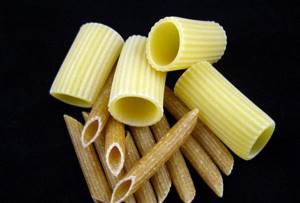
What are the health benefits of whole wheat pasta?
What we are used to eating as bread and noodles is a product with a high starch content. And this component leads to obesity. Its frequent use provokes cardiovascular diseases and even, possibly, cancer. Physician Sylvester Graham was the first to point out that flour made from whole grains is not as detrimental to health as its technologically refined sister. He advised using the most natural product possible. That's why the bread base, graham flour, was named after him. And later they began to make whole grain pasta from such raw materials. Dishes made from them taste slightly different from regular spaghetti and give a feeling of pleasant firmness - al dente. And their glycemic index is lower than that of our usual noodles - thirty-two versus forty.
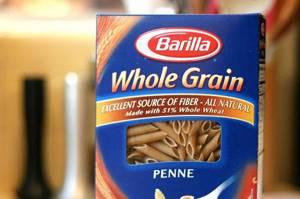
Comparison of calories between whole grains and regular grains
The difference, as you can see, is not very big. Especially if we take into account that the minimum daily human requirement for fiber (dietary fiber) is 25 g, it turns out that in order to provide it, you need to eat at least 1 kg of whole grain pasta, which is 1250 kcal.
There are 2-5 times more vitamins of group “B” in whole grain pasta, but none of them covers even 10% of the daily requirement, which means that we cannot seriously count on this source of vitamin B.
Magnesium in whole grain pasta - 30 mg versus 18 mg in regular pasta (only 0.5-1% of the daily requirement), iron - 1 mg versus 0.5 mg (only 2.5-5% of the daily requirement). Vitamin “E” is 0.3 mg versus 0.06 mg, and the daily requirement of vitamin E is at least 10 mg.
The glycemic index also does not differ much - 32 for whole grains and 40 for regular ones. This means that both types of pasta will not cause sudden spikes in blood sugar.
How to distinguish pasta made from whole flour from regular pasta?
Fortunately, this can be done by eye. Although pasta manufacturers proudly announce on the packaging that their products are correct. And the price increases noticeably, because you have to pay extra for healthy food. Pasta brands abroad, especially in Italy, are all good. Products are made from durum wheat. We'll talk about what this is below. But still, such spaghetti is made from refined rather than whole grains. If you buy pasta abroad and cannot read the labels on the packaging, take a closer look at the products themselves. Dark dots are visible on the surface of whole grain noodles - traces of the amniotic membrane.
Conclusion
Thus, the difference in the nutritional value of whole grain and regular pasta is insignificant, and does not allow us to say that whole grain pasta is much preferable for weight loss.
As for taste, the Internet presents the whole gamut of sensations from “the whole family liked it” to “how disgusting, I won’t touch it again.” Whole grain pasta tastes different from regular pasta, and it is best for the reader to try it and decide for himself whether he likes it.
If, nevertheless, you don’t like it, then know that you can lose weight on regular pasta in the same way as on whole grains. Remember a few universal tips that will help you continue to eat regular pasta and keep your figure in good shape.
Firstly, pasta should always be slightly undercooked (cooking al dente reduces the glycemic index by 10 units). Secondly, eat them only in the first half of the day, but under no circumstances in the evening. Thirdly, pasta should be seasoned with light sauces, for example, tomato, but in no case with fatty sauces, as is customary in Italian restaurants. You can eat pasta with vegetables, with mushrooms, for example, in this form.
And, if possible, instead of thick pasta and homemade pasta, use factory-made thin noodles and thin spaghetti - pastified, that is, industrially pressed products, have a glycemic index of 10 units lower.
What is durum wheat?
Many inexperienced consumers confuse these two terms. If whole grain flour is obtained as a result of special technological processing of various cereals, then products from durum wheat varieties initially depend on the selectively grown species. The ears undergo regular threshing, crushing and sifting. Products made from such flour are also healthier because they contain less starch and more fiber. In Italy, all wheat crops are so-called grano duro. The famous durum pasta is made from flour. Brands can be very different - it is important that the packaging bears the inscription “Semolina di grano duro”. This is a kind of quality mark.

Domestic correct pasta
Unfortunately, in the Russian Federation durum wheat is grown only in the Saratov region, Stavropol region and Altai. Small sown areas directly affect the high cost of products made from such flour. We can recommend the brands “Extra-M”, “Znatnye”, “Shebekinskie”, “Makfa”. The pasta of these brands differs from ordinary ones even in their appearance. They have a smooth surface with an even glassy cut. The pasta has an amber golden color, and the package is free of chips. The manufacturer indicates “Durum flour” and the grade on the label. The price starts from thirty rubles for a small pack. But you can’t skimp on your health. “Stanichnye” from . Whole grain pasta in Russia is produced by the manufacturer Diamart.





